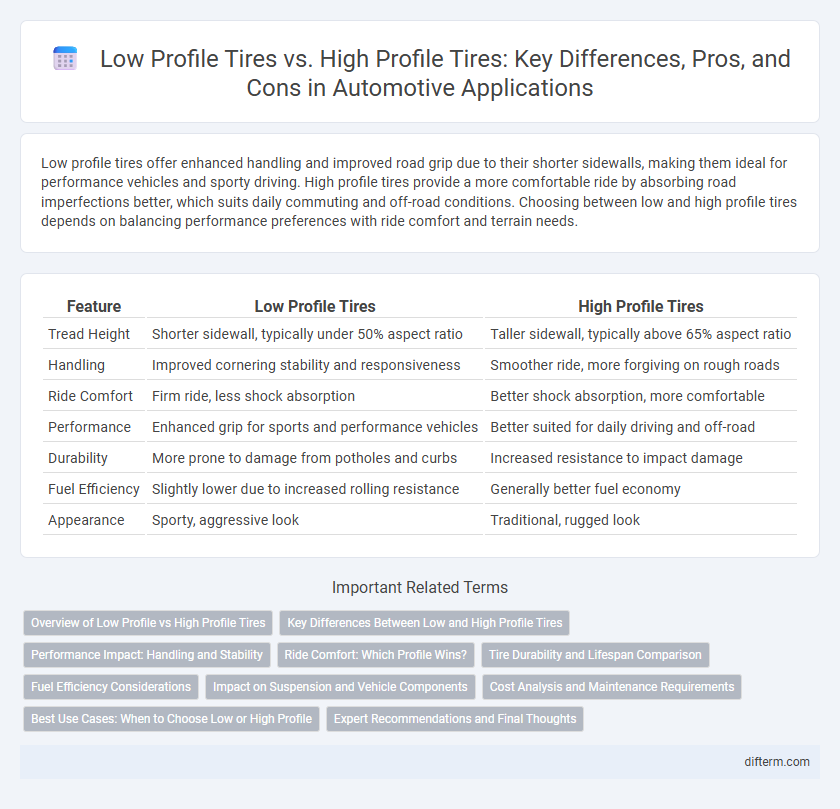Low profile tires offer enhanced handling and improved road grip due to their shorter sidewalls, making them ideal for performance vehicles and sporty driving. High profile tires provide a more comfortable ride by absorbing road imperfections better, which suits daily commuting and off-road conditions. Choosing between low and high profile tires depends on balancing performance preferences with ride comfort and terrain needs.
Table of Comparison
| Feature | Low Profile Tires | High Profile Tires |
|---|---|---|
| Tread Height | Shorter sidewall, typically under 50% aspect ratio | Taller sidewall, typically above 65% aspect ratio |
| Handling | Improved cornering stability and responsiveness | Smoother ride, more forgiving on rough roads |
| Ride Comfort | Firm ride, less shock absorption | Better shock absorption, more comfortable |
| Performance | Enhanced grip for sports and performance vehicles | Better suited for daily driving and off-road |
| Durability | More prone to damage from potholes and curbs | Increased resistance to impact damage |
| Fuel Efficiency | Slightly lower due to increased rolling resistance | Generally better fuel economy |
| Appearance | Sporty, aggressive look | Traditional, rugged look |
Overview of Low Profile vs High Profile Tires
Low profile tires feature shorter sidewalls and larger rims, offering improved handling, sharper cornering, and enhanced aesthetic appeal for performance and sports vehicles. High profile tires have taller sidewalls, providing greater cushioning, better shock absorption, and increased comfort for off-road and everyday driving conditions. Choosing between low profile and high profile tires depends on driving preferences, road conditions, and vehicle type, with low profiles favoring agility and high profiles emphasizing ride comfort.
Key Differences Between Low and High Profile Tires
Low profile tires feature a shorter sidewall height, enhancing cornering stability, steering responsiveness, and aesthetic appeal, making them ideal for performance vehicles. High profile tires offer a taller sidewall that absorbs road irregularities better, providing a more comfortable ride and increased protection against wheel damage on rough terrains. The choice between low and high profile tires impacts handling dynamics, ride comfort, and suitability for various driving conditions.
Performance Impact: Handling and Stability
Low profile tires improve handling by offering increased steering responsiveness and enhanced cornering stability due to their stiffer sidewalls and larger contact patches. High profile tires provide better ride comfort and absorb road irregularities more effectively but may result in less precise handling and reduced stability at high speeds. Choosing between low and high profile tires depends on balancing performance needs with ride quality preferences for specific vehicle applications.
Ride Comfort: Which Profile Wins?
Low profile tires feature shorter sidewalls that provide sharper handling and improved steering responsiveness but often result in a firmer ride due to reduced cushioning from road imperfections. High profile tires, with taller sidewalls, absorb shocks more effectively, delivering superior ride comfort by minimizing vibrations and harshness over rough surfaces. For everyday driving focused on comfort, high profile tires generally outperform low profile options by offering a smoother and more forgiving ride experience.
Tire Durability and Lifespan Comparison
Low profile tires typically have shorter sidewalls that offer enhanced handling but may wear out faster due to increased exposure to road impacts and heat. High profile tires with taller sidewalls provide better shock absorption, resulting in improved durability and longer lifespan under varied driving conditions. Comparing tread wear rates, high profile tires generally offer more consistent wear patterns, contributing to extended tire longevity.
Fuel Efficiency Considerations
Low profile tires typically offer lower rolling resistance compared to high profile tires, which can enhance fuel efficiency by reducing energy loss. The stiffer sidewalls of low profile tires improve handling precision and reduce drag, contributing to better mileage on highways. However, high profile tires provide greater cushioning and can slightly increase rolling resistance, potentially lowering fuel economy in stop-and-go city driving conditions.
Impact on Suspension and Vehicle Components
Low profile tires provide improved handling and responsiveness by reducing sidewall flex, which enhances suspension performance but can increase stress on suspension components and wheel bearings. High profile tires offer better shock absorption and cushioning over rough surfaces, reducing wear on suspension parts but potentially compromising cornering stability. Choosing between these tire profiles depends on balancing performance benefits with the durability of suspension and steering system components.
Cost Analysis and Maintenance Requirements
Low profile tires generally cost more upfront due to advanced materials and performance design, while high profile tires offer a more budget-friendly option with longer tread life. Maintenance for low profile tires includes frequent alignment checks and vulnerability to damage from potholes, resulting in higher repair costs compared to high profile tires that provide better shock absorption and durability. Cost analysis reveals high profile tires reduce long-term expenses due to lower replacement frequency and less frequent repairs, suitable for daily driving and off-road conditions.
Best Use Cases: When to Choose Low or High Profile
Low profile tires offer enhanced handling and cornering performance, making them ideal for sports cars and performance vehicles on smooth roads or track conditions. High profile tires provide better cushioning and comfort over rough terrain, suitable for SUVs, trucks, and off-road driving where impact absorption is crucial. Choosing between low and high profile tires depends on the vehicle's purpose, road conditions, and desired balance of performance versus ride comfort.
Expert Recommendations and Final Thoughts
Experts recommend low profile tires for enhanced handling and improved cornering stability, making them ideal for performance-oriented vehicles. High profile tires are favored for comfort and durability, providing better shock absorption and a smoother ride on rough terrain. Final considerations emphasize selecting tire profiles based on driving conditions, vehicle type, and balancing performance needs with ride comfort.
low profile tires vs high profile tires Infographic

 difterm.com
difterm.com